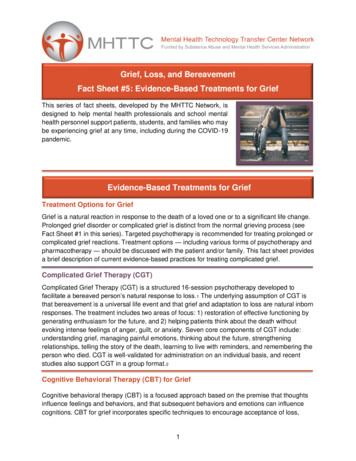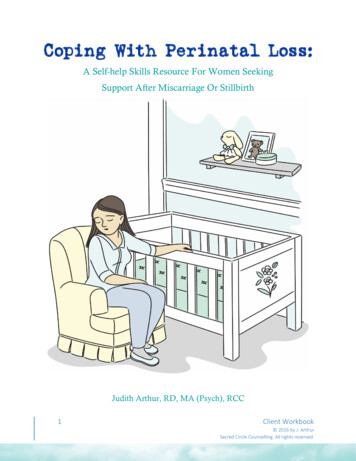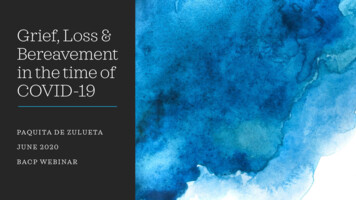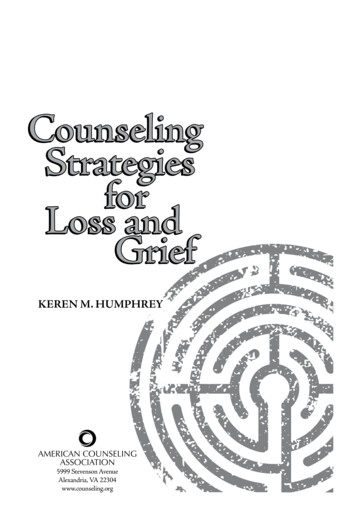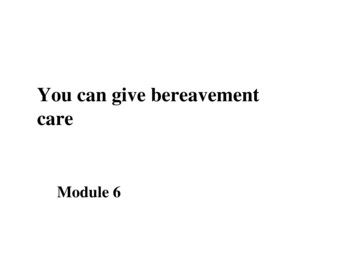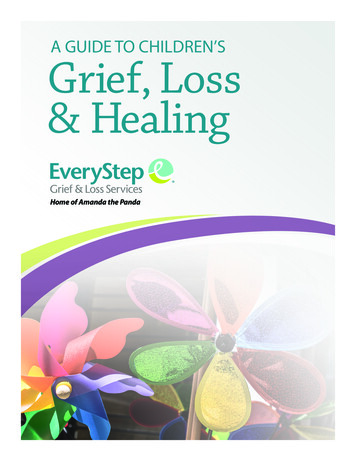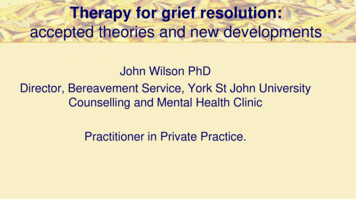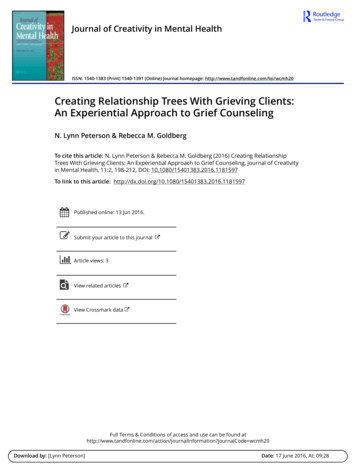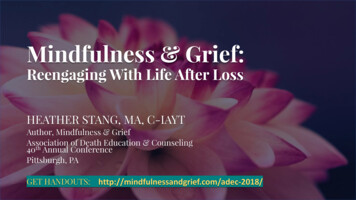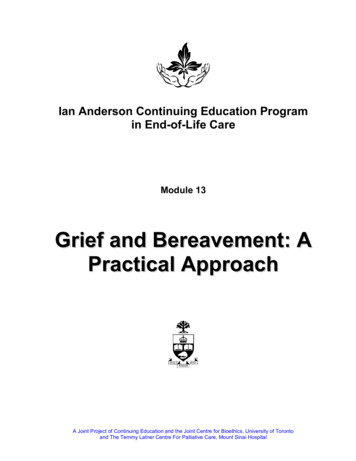
Transcription
Ian Anderson Continuing Education Programin End-of-Life CareModule 13Grief and Bereavement: APractical ApproachA Joint Project of Continuing Education and the Joint Centre for Bioethics, University of Torontoand The Temmy Latner Centre For Palliative Care, Mount Sinai Hospital
Authors:S. L. Librach MD, CCFP, FCFPW. Gifford-Jones Professor in Pain Control and Palliative Care, University of TorontoDirector, Temmy Latner Centre for Palliative Care, Mount Sinai HospitalPauline Abrahams, BSc, MBChB, CCFPStaff Physician, Temmy Latner Centre for Palliative Care Psychosocial SpiritualProgram, Mount Sinai HospitalLecturer, Dept. of Family & Community Medicine, University of Toronto University of Toronto 2004Ian Anderson Program in End-of-Life CareModule 13Grief and Bereavement: A Practical Approach2
Case Scenario – Adrienne MacphersonScenario 1Adrienne is a 68-year-old woman. She lives with her husband Andrew, age 79, in amodest bungalow in a rural area about 10 minutes from town. Andrew wasdiagnosed with lung cancer with metastases to liver and bone 10 months ago.Andrew had been feeling unwell for several months before seeking medicalattention. He now is very weak and spends most of his time in bed. He has pain thatis poorly controlled and eats very little. At times, he is quite confused.Adrienne and Andrew have been married for 46 years. This is Adrienne’s secondmarriage. She was married for two years to Pierre, a soldier in the army who waskilled in Korea. Adrienne was left with one child, a daughter Isabel now age 50.Three years after Pierre’s death she met Andrew at work and they married two yearslater. Adrienne and Andrew had three children, a son Alistair now age 43, a sonJean age 36 and a daughter Anne who died in a motor vehicle accident 10 yearsago at age 24. Isabel lives in town nearby but Jean lives in Seattle.Adrienne worked as a clerk in a department store for many years before retiring 10years ago because of health problems, rheumatoid arthritis. Andrew was anaccountant with his own small firm. They now live on their small pensions.Scenario 2“Doctor? Sorry to bother you but this is Isabel, Andrew Macpherson’s stepdaughter.First of all, I would like to thank you for the care you gave my Dad. He died verypeacefully at home thanks to you. It meant a lot to all of us and we still miss him alot. Oh, well life is like that isn’t it?”“Why I called you as well was to talk about my Mom, Adrienne. It has been about sixmonths since Dad died. She really is not getting any better. I am really worried abouther. I try to see her every day now if I can. She is just sitting there in a corner chairmost of the time. She eats very little and the house is a mess. She just doesn’t seemto care any more and that is not like her at all. When I talk about my kids, sheoccasionally brightens up but then she begins to cry. I have asked her to go and seeyou but she hasn’t made an appointment. I finally called and made her anappointment to see you next week. I just wanted to fill you in. My brothers and I arevery concerned.”“Thanks for filling me in, Isabel. Are you coming with her? I think that would behelpful.” University of Toronto 2004Ian Anderson Program in End-of-Life CareModule 13Grief and Bereavement: A Practical Approach3
Module Objectives1.2.3.4.5.Define grief & bereavementDescribe some of the models of griefDescribe factors influencing griefDescribe complicated griefDescribe a practical approach in the management of griefIntroductionGrief is a normal phenomenon common to all of us. As we go through life, weexperience a wide variety of losses for which we grieve. It is not possible to gothrough life without suffering losses. Grief is the response to any loss and istherefore a common human experience. Grief is a common but often unrecognizedpart of life cycle changes. Many of the difficult situations we have faced in our liveshave been situations where there has been loss & subsequent grief.We often see grief as interfering with life, rather than being intrinsic to life.Subsequently we may not mentor our children concerning this aspect of life. On thecontrary, we try to protect them, not only from death, but often also from the littlelosses that happen throughout our lives and which can prepare us for greater ones.Often avoided or unacknowledged throughout much of our life, grief is allowedlegitimate (if somewhat curtailed) expression in connection with illness andespecially life threatening disease, dying and death. At these times many pastsorrows or a history of harm that have been suppressed, either consciously orunconsciously, may be re-activated at a subliminal level, fueling our responses tothe current situation with a lifetime of unexpressed grief and unexamined losses. Weare overwhelmed, not only because of our present loss, but because we arrive atthis point of our lives without the benefit of having learnt anything useful from ourprevious losses.A terminal illness or indeed any chronic illness is replete with successive losses andconsequent grief. Losing your own life i.e. dying is associated with grief. Losing aloved one is also associated with grief. Who feels the grief -all ages, all persons andoften care providers. Grief starts with the symptoms of illness and the diagnosis ofany illness.Good end-of-life care has incorporated the concept of good grief (i.e. a healthyexpression of our life force) as part of a good death. This module is a briefexploration of the issues of grief and its management in providing good end-of-lifecare. University of Toronto 2004Ian Anderson Program in End-of-Life CareModule 13Grief and Bereavement: A Practical Approach4
Grief is:! a life experience to be lived! a mystery to be entered! a stimulus for compassion and kindness! a reminder of who and what we have loved! a longing for relatednessDefinitionsGrief is the process of spiritual, psychological, social & somatic reactions to theperception of loss.Mourning is the cultural response to grief.Bereavement is the state of having suffered a loss.1Grief work is the work of dealing with grief, requiring the expenditure of physical,emotional and spiritual energy.2Models and Theories of GriefThere have been a number of models proposed for grief in the past. Recently,however, as a result of clinical experiences, those in the field of grief counseling andtherapy as well as grief counselors in palliative care, have begun to question thestandard models of grieving. Briefly the components of the older models include:1. An identifiable, normal psychological process of mourning with standardcharacteristics or stages.2. The function of mourning is conservative and restorative – “to get back tonormal”.3. Mourning is a private, intrapsychic process, its affect arising spontaneouslyfrom within the individual.4. Mourning is only painful and sad.5. The central task is detachment, the relinquishing of attachment to thedeceased.6. The normal process leads to full resolution.7. The symptoms are the issues to pay attention to.Newer theories and ideas of grief challenge many of those beliefs, stating:1. There is a personal reality of death and loss that is different for each individual,culture, subgroup etc “grief happens within the context of a life story”(Rando).2. The function of grief is transformative, “we relearn ourselves, we relearn theworld” (Attig) University of Toronto 2004Ian Anderson Program in End-of-Life CareModule 13Grief and Bereavement: A Practical Approach5
3. Mourning is fundamentally an inter-subjective process and many problemsarising from it are due to the failure of others to engage with the bereavedperson (Hagman).4. Grief involves a full range of affect including humor and joy.5. Grieving involves the creation of continued symbolic bonds with the deceasedperson “relationship in absence”.(Attig)6. Grief is open-ended and evolving, being continually transformed throughout thelifecycle as we encounter new losses.7. It is the meaning behind the symptoms that are important for the individual,leading to “an increased appreciation of the possibility of life enhancing posttraumatic growth as one integrates the lessons of loss” (Neimeyer).Grieving is:! active! healing! skillful! transformative! connective! socialBackground Issues and Factors in Grief1. A single loss will precipitate other losses. For example the physical loss of abreast through a mastectomy for breast cancer will cause losses in the areas ofbody image, sexuality, role, good health and independence.2. Characteristics of the bereaved influence grief outcomes:# There is inconclusive evidence that men do more poorly than women butthere are differences in the way grief may be handled.# There are more consequences in children especially if grief is not managedwell.# Older persons in general may have less intense & fewer reactions but thisdepends somewhat on the relationship to the deceased. Often overlooked isthe intense grief subsequent to the loss of adult children.# Poor physical health may limit the ability to expend the necessary physicaland psychic energy to integrate grief into our lives.# The use of drugs such as psychotropic agents.# A previous history of psychiatric problems or addictions like alcoholism.# There are few conclusive studies about the influence of personality variablesand the course and outcomes of grief.# Patterns of coping.# Past or current experiences with grief.# Current other psychological or social problems or crises.# Culture, ethnicity & religion.3. The relationship to the deceased influences the course of grief:# There is a unique nature to each relationship.6 University of Toronto 2004Ian Anderson Program in End-of-Life CareModule 13Grief and Bereavement: A Practical Approach
The role that deceased had in family e.g the power authority in the family.# The amount of unfinished business in the relationship.# Families who have had long-term dysfunctional patterns of interactions willreact in their usual patterns of coping.The nature of the death may be a factor in grief course and outcomes:# There are no studies indicating significant differences between acute vs.chronic deaths as far as outcomes are concerned but many of studies havenot been done in populations receiving good palliative care.# Violent deaths such as those secondary to crime or accidental deaths.# Suicidal death.Characteristics of the deceased:# The age of the deceased particularly if young will affect the course andoutcomes of grief.# The type of person the deceased was.# The timeliness (e.g. at retirement, around the time of an important event suchas the birth of a grandchild, a marriage of a child, etc.) may influence thecourse and outcome of griefThe adequacy of social support:# Persons lacking or withdrawing from support may have worse outcomes.# Remarriage or other close or intimate relationships protect.# Culture.There are gender issues that may influence the expression and course of grief:# Staudacher in her book “Men and Grief” indicates that men may havedifferent coping styles than women:# To remain silent.# To engage in solitary mourning or “secret” grief.# To take physical or legal action.# To become immersed in activity.# To exhibit addictive behaviour.Children & Grief# Children of all ages grieve & grief is particular to age groups.# Children should not be protected from grief, funerals or issues of death &dying.# They need to be educated in terms they can understand.# Parents must be involved in the education.# Children cope with grief according to their developmental stage and may revisit a grieving situation as they reach new developmental stages; forexample, a death witnessed as a toddler can resurface and need to beaddressed again in a 7-year-old.#4.5.6.7.8.Psychological Phases of Normal GriefDoes grief have distinct phases? Quite a number of authors have defined phasesand tasks of grief. The issue is that these may not be chronological phases but really University of Toronto 2004Ian Anderson Program in End-of-Life CareModule 13Grief and Bereavement: A Practical Approach7
concurrent processes that may be more active at certain times in the grief process.Grief is also an individual experience.There also has been discussion of whether there is an entity such as “anticipatorygrief”, the grief felt in anticipation of a loss. Many of those involved as griefcounselors feel that anticipatory grief is just grief and that by giving it another nametends to trivialize somewhat the depth of emotions during the time of anticipating theloss.The following is blend of some of the ideas about phases and the psychologicalreactions to loss.3 These are to be interpreted not as sequential but more likelyconcurrent processes through much of the grief experiences that change and remitover time until healing occurs.Acute or Self Protective Phase:####Initial shock, denial and disbelief.May feel dissociated from the world around themIf family well prepared, there may not be the same amount of shock oravoidance.May sometimes initially see an intellectualized acceptance (e.g. “Well, he wasold in any case.”) without an emotional component as an initial denial of theloss, rather than a necessary self protective mechanism.Confrontation:#############Most intense experience of grief.Emotional extremes common-an emotional “roller coaster”.Rapid and large swings in emotion often cause fear & more anxiety.Anger is a common component including anger that may be directed towardsphysicians and other health care team members.Guilt, inwardly directed anger, confronts the bereaved with questions of “Whatif I had .?”, “Did I do enough?”, “What did I do wrong?” “What did I do todeserve this?”Survivor guilt. “Why wasn’t it me?”Sadness & despair.Inability to concentrate or process information.Preoccupation with the deceased.Over time the extreme emotional swings lessen.Intermittent denial may also occur.Social manifestations of this phase include:! Restlessness & inability to sit still.! Lack of ability to initiate & maintain organized patterns of activity.! Difficulty completing or concentrating on tasks at work.! Withdrawal from the very people who may be able to help.Physiological or somatic manifestations of grief:! Common in this phase. University of Toronto 2004Ian Anderson Program in End-of-Life CareModule 13Grief and Bereavement: A Practical Approach8
Often these complaints bring the bereaved into physicians’ offices.The elderly bereaved are a group vulnerable to new illness andexacerbations of symptoms of old illnesses and physical symptoms mustbe addressed appropriately.! Symptoms may include: Anorexia & other GI disturbances. Loss of weight. Sleep disturbances. Fatigue & weakness. Palpitations. Anxiety states. Shortness of breath.Spiritual issues:! The basic search for meaning and value in life become questions thathave to be dealt with by the bereaved, i.e. “who am I?”! Not a synonym for religion but religion is one form of expression ofspirituality.! The feeling of abandonment by G-d/higher power.! The feeling of anger towards G-d/higher power.! Fear of the unknown.! Finding a secular framework to face the unknown – the mystery of death.!!#Reestablishment:###Grief gradually softens to an “acceptance” of the reality of the loss.Gradual decline in symptoms as grief becomes integrated into life.Grief is compartmentalized but periods of grief may arise at specific timessuch as holidays, birthdays, etc.Complicated GriefA number of terms have been used to describe grief experiences that do not seemto be “normal”-abnormal, atypical, unresolved, difficult and complicated. The term“complicated grief” will be used here to describe grief that does not proceed to goodhealing.1. Delayed or absent grief. Those who are bereaved seem to carry on withoutmuch evidence of grieving. Caution must be used in over-interpretingpersonal ways of coping as delayed or absent grief. Some people will notdiscuss or reveal their emotions in public. Others exhibiting delayed grief maybe involved in settling other issues before they can openly grieve. It oftentakes some unrelated event, often another loss, to bring out the flood ofemotions. Totally absent grief may be a sign of complete denial and it is quiterare. University of Toronto 2004Ian Anderson Program in End-of-Life CareModule 13Grief and Bereavement: A Practical Approach9
2. Conflicted grief. This is a distortion or prolongation of one of the phases orgrief or one of the phase components. The commonest are extreme anger orextreme guilt.3. Chronic grief. For those who suffer from this complicated grief, it is like thegrief is fresh all the time. This may be indicative of a relationship with thedeceased that was very problematic, had a lot of unfinished business or wasquite dependent in nature.4. Psychiatric disturbances associated with grief. Grief can be the cause ofmajor psychiatric illness especially depression. This may of course delay theresolution of grief.5. Physical illness associated with grief. The development of significantintercurrent illnesses in those who are bereaved may delay the resolution ofgrief until the illness has passed. If the illness is very serious, grief reactionsmay deepen.The Tasks of Grief and MourningDealing with grief requires some work on the part of those who are grieving. Thesetasks begin for members of the family and for the patient early on in the illness.Worden initially wrote about the tasks of mourning and the goals of grief counseling.These have been reproduced in the box below with some modifications to reflect anapproach that begins during the illness.The Four Tasks of Grief & Mourning (Worden)To accept the reality of the loss.To experience the pain of grief.To adjust to an environment of change & prepare for the death.To withdraw emotional energy & eventually reinvest it in other relationships.Grief Counselling GoalsTo increase the reality of the loss.To help those who grieve deal with both experienced & latent affect.To help families discover & deal with impediments to readjustment.To encourage the bereaved to make a healthy emotional withdrawal from thedeceased & reinvest energy into other relationships.Helping the Patient and Family Deal with GriefBasic Issues1. Begin grief counseling if possible while the patient is still alive. This will oftenhelp reduce a patient’s suffering and make the bereavement phase easier on10 University of Toronto 2004Ian Anderson Program in End-of-Life CareModule 13Grief and Bereavement: A Practical Approach
the family. Focus on issues such as life meaning, the contributions of thedying person and the legacy left behind.2. The family is the unit of care and grief counseling before and after thepatient’s death should be focused on the individual and family. The goal is tobuild stable and positive family environments in the face of loss.3. Grief is a normative process and requires much listening and often not a lot ofintervention on the part of the counselor. Just explaining the normal aspectsof grief is reassuring and supportive. Explain that grief is a unique process ineach individual and there is no right way. Build and practice concrete skills tosupport healthy families.4. Allow sufficient time to grieve. No definite time but most people resolve to alevel of functioning around one year. Some individuals and families willaccomplish the tasks of grieving in two years. Families that have receivedadequate palliative care often will do this well within a year. Advocate forsufficient time off from work for the bereaved especially in the first few weeksof bereavement. Discuss the fact that grief spikes continue for life throughevents, holidays and “anniversary” reactions.5. Emphasize the role of the funeral and of memorial service. Encouragefamilies to bring children to these rites. Community expression of grief helpsthe family. Attend these services if the patient and family have been close toyou. Your grief is important too and needs some closure to relationships.Consider having memorial services in hospitals, agencies and palliative careprograms for bereaved families and for staff.6. Encourage the family to begin to deal with the deceased’s personalpossessions. Suggest that some of these can be gifts to family members toremember the deceased or gifts to charity so that there is a sense that thedeceased continues to contribute and has a continuing legacy.7. Medications, particularly tranquillizers and antidepressants are usually notneeded for any sustained period of time. Avoid medications unless there issubstantial evidence of depression or severe anxiety states that are retardingresolution of grief.8. Contact the bereaved at regular intervals. This can be facilitated throughvolunteers but a call or card from the physician about one month after thedeath is often very helpful to families. Definitely monitor any families with highrisk for grief problems.9. Identify concurrent problems that may interfere with normal grief.10. Use resource books and Internet sites that deal with grief to help thebereaved.11. Monitor children at school for grief problems manifesting as school problems.12. Investigate to see what types of bereavement programs exist in yourcommunity. Hospice palliative care programs often have associatedbereavement groups.13. Ask for expert help if you sense there is complicated grief.The Nature of Grief WorkMuch of the nature of grief work in palliative care is geared to be:11 University of Toronto 2004Ian Anderson Program in End-of-Life CareModule 13Grief and Bereavement: A Practical Approach
a) Family (friendship) orientated:! The ability to accept loss is at the heart of all skills in healthy familyrelations (Walsh and McGoldrick).b) Relational! Opportunities for resolution, forgiveness, gratitude.c) Intergenerational! How we want to be remembered.! Legacy work e.g. what are we leaving behind as a legacy.! Healthy and effective parenting model.! Mentorship re: coping skills with children.! Decreasing fear in future generations. Teaching children. Learning from children.! People die, relationships don’t.d) Psycho educative! Anxiety about the unknown! What changes to expect: Forewarned is forearmed. Physical Emotional Changing family dynamics/roles.e) Harm reductive/preventative.! Identifying destructive coping mechanisms. i.e. alcohol/drug use.f) Community oriented.! Looking at the larger social interaction e.g. in school or workplace.g) Active:! What we need to do in order to integrate how we are changed?h) Narrative.! Richly descriptive in elucidating personal meaning-‘Tell me what it is yousee death or this loss as?”i) Supportive! Facilitating the safe containment of emotional space.j) Intrapsychic:! Facilitating connection to our own deeper wisdom and ability to healourselves.! An affirmation and validation of our own humanity and mortality.k) Spiritually supportive.! We are dealing with the unknown, with life’s mysteries.Grief in ChildrenGrief in children depends on their developmental stage, relationship with thedeceased and the circumstances of the death. Children definitely express theirfeelings of grief differently than adults:# They often do not display their feelings as openly as adults.12 University of Toronto 2004Ian Anderson Program in End-of-Life CareModule 13Grief and Bereavement: A Practical Approach
####They often can immerse themselves in their usual activities while still havingstrong feelings of anger and continuing fears of abandonment and death.Their grief while appearing more intermittent and brief, it usually lasts longerand requires constant support and monitoring.As children grow and develop, they often revisit their grief at significant lifeevents.They may express their grief through extremes of behaviour-from beingaggressive to being very passiveChildren’s understanding about death depends on their developmental stage (13):# Children 0-3 do not have clear concepts of death. The emotional expressionand dependable presence of loved ones are more important than the wordsused. Since these children may equate death with sleep, explanations thatcompare death to sleep should be avoided. Otherwise abnormal fear of sleepor nighttime may occur. Children in this age group may sense the grief inothers and protecting them form the pain of grief may lead to physical andemotional changes such as weight loss, anorexia, sleep disturbance,listlessness and other changes in activity.# Children 3-6 often consider death as a reversible event. They often haveimages from television cartoons that death is temporary. They also mayexpress “magical thinking” believing they in some way that they caused thedeath or that they can reverse the death. They may regress and showdisturbances in eating, sleeping and toileting.# Children 6-9 may be more aware of the finality of death but do not believe it isuniversal. In their grief they can become aggressive or overly clingy.# By age 9 or 10, most children understand that death is final and universal.The child should be told about death in language that is appropriate for theirdevelopment often using age specific resources such as books, films and videos.Children’s attendance at funerals is also important. They can participate andobserve the family and community grief responses. They need to be prepared aheadof time for what they are to see and can be encouraged to participate in the service ifthey are old enough and if that participation fits with family values and culture.Indicators in children of atypical grief may include:# Continued denial of the death.# Prolonged anger.# School problems that are not resolving.# Behavioural problems that did not exist before.# Persistent physical symptoms such as sleep disturbances, eating disorders,etc.# Social withdrawal.# Disabling or persistent regression.13 University of Toronto 2004Ian Anderson Program in End-of-Life CareModule 13Grief and Bereavement: A Practical Approach
Children displaying any of the above should be referred to experienced counselorsfor management since unresolved grief may lead to serious emotional andpsychological problems and even suicide.SummaryGrieving is the active way by which we incorporate grief into our lives and discoverhow we are changed by it. It is open-ended and is continually transformed as we gothrough life and experience further losses. As caregivers we need to be self-awareand develop a respect for our own grief and for another’s grief. If we cannot bear ourown grief, it will be hard to work in the presence of another person’s grief.Soygal Rinpoche says, “If you are in a position to help others, it is through your ownsuffering that you will find the understanding and compassion to do so”. And Rilkewrites, “The protected heart that is never exposed to loss, innocent and secure,cannot know tenderness”.The sparrow digests food by eating gravel, it helps grind upthe food the body needs to survive. Is grief the gravel thathelps us digest/integrate life’s pain? Is grief the gravel for oursoul’s survival?14 University of Toronto 2004Ian Anderson Program in End-of-Life CareModule 13Grief and Bereavement: A Practical Approach
Case Scenario – Adrienne MacphersonScenario 1Adrienne is a 68-year-old woman. She lives with her husband Andrew, age 79, in amodest bungalow in a rural area about 10 minutes from town. Andrew wasdiagnosed with lung cancer with metastases to liver and bone 10 months ago.Andrew had been feeling unwell for several months before seeking medicalattention. He now is very weak and spends most of his time in bed. He has pain thatis poorly controlled and eats very little. At times, he is quite confused.Adrienne and Andrew have been married for 46 years. This is Adrienne’s secondmarriage. She was married for two years to Pierre, a soldier in the army who waskilled in Korea. Adrienne was left with one child, a daughter Isabel now age 50.Three years after Pierre’s death she met Andrew at work and they married two yearslater. Adrienne and Andrew had three children, a son Alistair now age 43, a sonJean age 36 and a daughter Anne who died in a motor vehicle accident 10 yearsago at age 24. Isabel lives in town nearby but Jean lives in Seattle.Adrienne worked as a clerk in a department store for many years before retiring 10years ago because of health problems, rheumatoid arthritis. Andrew was anaccountant with his own small firm. They now live on their small pensions.Scenario 2“Doctor? Sorry to bother you but this is Isabel, Andrew Macpherson’s stepdaughter.First of all, I would like to thank you for the care you gave my Dad. He died verypeacefully at home thanks to you. It meant a lot to all of us and we still miss him alot. Oh, well life is like that isn’t it?”“Why I called you as well was to talk about my Mom, Adrienne. It has been about sixmonths since Dad died. She really is not getting any better. I am really worried abouther. I try to see her every day now if I can. She is just sitting there in a corner chairmost of the time. She eats very little and the house is a mess. She just doesn’t seemto care any more and that is not like her at all. When I talk about my kids, sheoccasionally brightens up but then she begins to cry. I have asked her to go and seeyou but she hasn’t made an appointment. I finally called and made her anappointment to see you next week. I just wanted to fill you in. My brothers and I arevery concerned.”“Thanks for filling me in, Isabel. Are you coming with her? I think that would behelpful.”15 University of Toronto 2004Ian Anderson Program in End-of-Life CareModule 13Grief and Bereavement: A Practical Approach
Detailed Case ScenarioAdrienne is a 68-year-old woman. She lives with her husband Andrew, age 79, in amodest bungalow in a rural area about 10 minutes from town. Andrew wasdiagnosed with lung cancer with metastases to liver and bone 10 months ago.Andrew had been feeling unwell for several months before seeking medicalattention. He now is ver
Grief is the process of spiritual, psychological, social & somatic reactions to the perception of loss. Mourning is the cultural response to grief. Bereavement is the state of having suffered a loss.1 Grief work is the work of dealing with grief, requiring the expenditure of physical, emotional and spiritu

